Last Updated 05/28/2024
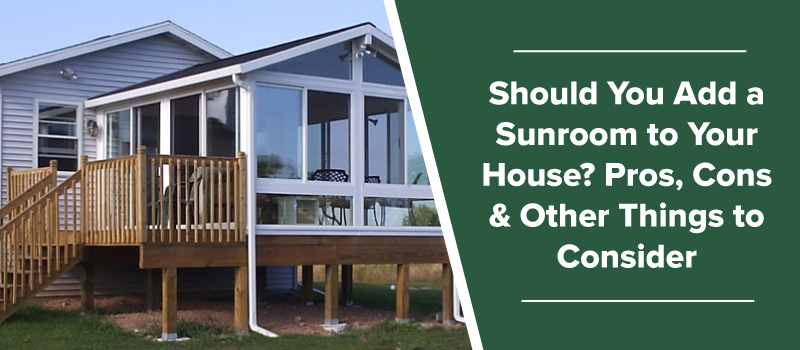
Picture yourself on a bright, cheery morning. You’re sitting, enjoying the outdoor view. The sun is shining and nature is unfolding before your eyes. You sip your hot beverage and go back to your reading. In the background, soft music plays. The smell of fresh baking wafts in the air. Peace and tranquility surround.
But wait. Something’s missing. There’s no wind blowing papers off the table. No flies buzzing about, examining your food or landing in your hair. It might even be the middle of winter with newly-fallen snow on the branches or a cool spring day with flowers peeking out from thawing ground. Yet you’re warm, totally comfortable and entirely relaxed.
That’s because you’re sitting in your new sunroom and know it’s the best investment you’ve ever made in your home. Adding a sunroom to your house was always your dream, but it didn’t become a reality until you researched your options. Making an informed decision before investing in a sunroom addition took prudent due diligence but was well worth the time.
This picture could be you after looking at what’s available for building a sunroom. You’ll hear the terms “three-season sunroom” and “four-season sunroom” as well as “patio covers,” “screen rooms” and “conservatories.” You’ll wonder, “Should I add a sunroom to my house?”, “What time of year should I add a sunroom?” and “How much does it cost to add a sunroom to my house?”.
The terms and questions are normal for industry professionals who build sunrooms. Adding a sunroom to your home is more than most do-it-yourselfers can take on. However, experienced sunroom craftspeople will make your sunroom addition as stress-free as when you’re finally sitting there enjoying it.
No doubt you’re thinking about the advantages and disadvantages if you add a sunroom to your house. Those are natural considerations. They follow even the most basic question, and that’s “What is a sunroom for?” To help you make that informed decision, let’s take a look at the pros and cons of sunrooms as well as other things to consider.
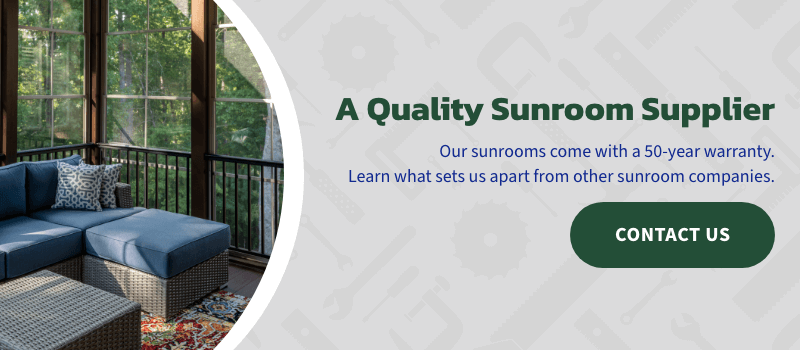
What Is A Sunroom?
Sunrooms are a structure surrounded by glass with screened openings that can be opened or closed depending on your choice. It’s often referred to as a patio sunroom, glass patio sunroom enclosure, solarium, outdoor enclosure, and, occasionally, as a Florida room. Since sunrooms are made primarily out of glass, they are great for letting in natural light.
A sunroom is a special place in your home. It’s where you bring the outdoors inside yet control your environment by buffering you from nature’s elements. That includes heat, cold, rain, wind, snow and especially the bugs. Sunrooms are the perfect solution to enjoying your view of the outdoors while experience the comfort of the inside.
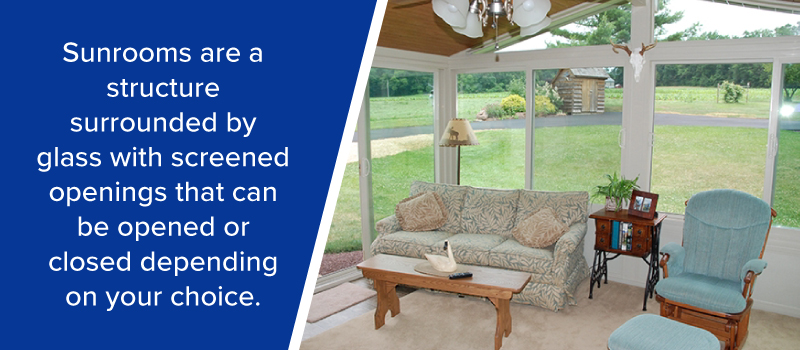
After the original house is built, homeowners often add sunrooms as an affordable interior living space that extends into nature. There are many different styles and configurations of sunrooms. The best designs work to blend in with your existing structure and appear part of your home, not something stuck on as an afterthought.
Openness and visibility are the two big benefits sunrooms deliver. They’re also affordable, with most sunroom additions being less cost than conventional construction. Sunrooms often use existing bases like concrete patios or wooden decks and have opaque roofs as opposed to solid shingles.
Think of your sunroom as a modern-day porch. For years, American homes were built with front or back porches where families would gather or older adults would sit to enjoy the outdoors while being partly protected. That lasted only until the rain and wind or wasps and bees sent people scurrying inside to watch nature from the kitchen window.
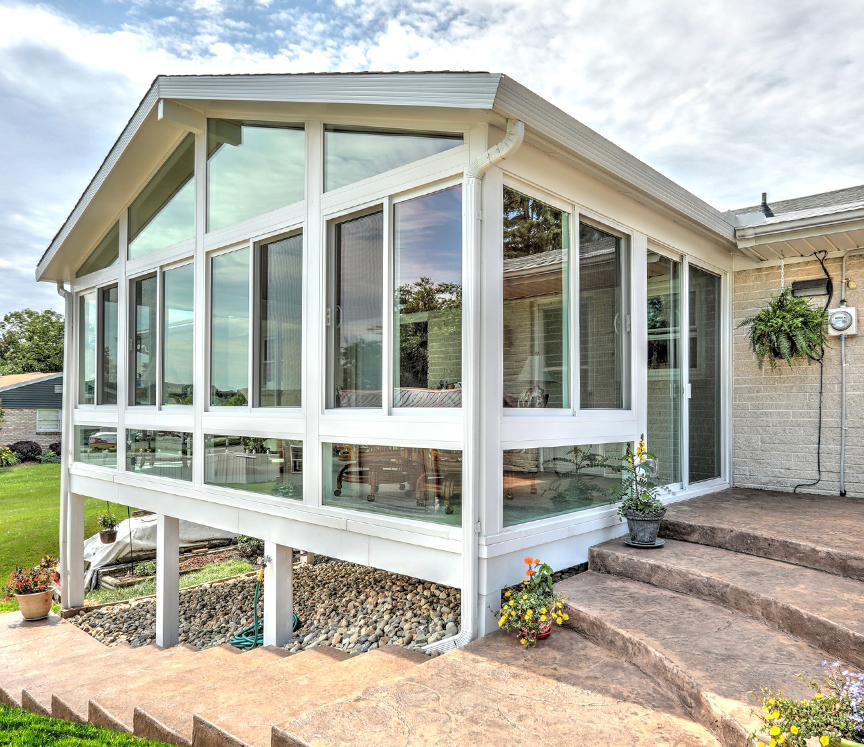
Sunrooms evolved as conversions of porches and patios, and are now often referred to as patio sunrooms. As technology advanced, the materials available offered creative uses where outdoor spaces were captured and contained for multi-weather living. A patio sunroom is now built of lightweight and high-tech products like:
- Aluminum
- Structural vinyl
- Engineered roof panels
- Insulated, thermally-broken glass
- Solar-treated, low emissivity (Low-E) glass
- Radiant heating and air conditioning devices
Pros to Sunrooms
But what is a sunroom for exactly? Sunroom uses are as varied as their occupants. Besides the main spirit of naturally bringing the outdoors in and incorporating natural light, sunrooms add space and function for all kinds of activities. Some versatile uses are:
- Sitting and enjoying views while protected
- Relaxing in a spa-like retreat
- Quiet sanctuary for reflection and contemplation
- Enjoying afternoon tea or a good book
- A perfect home office
- Television or music rooms
- Children’s play area
- Cozy space for family gatherings
- Flex-space for multi-activities, games and crafts
- Exercise and workouts
- Greenspace for plants, birds and even fish ponds
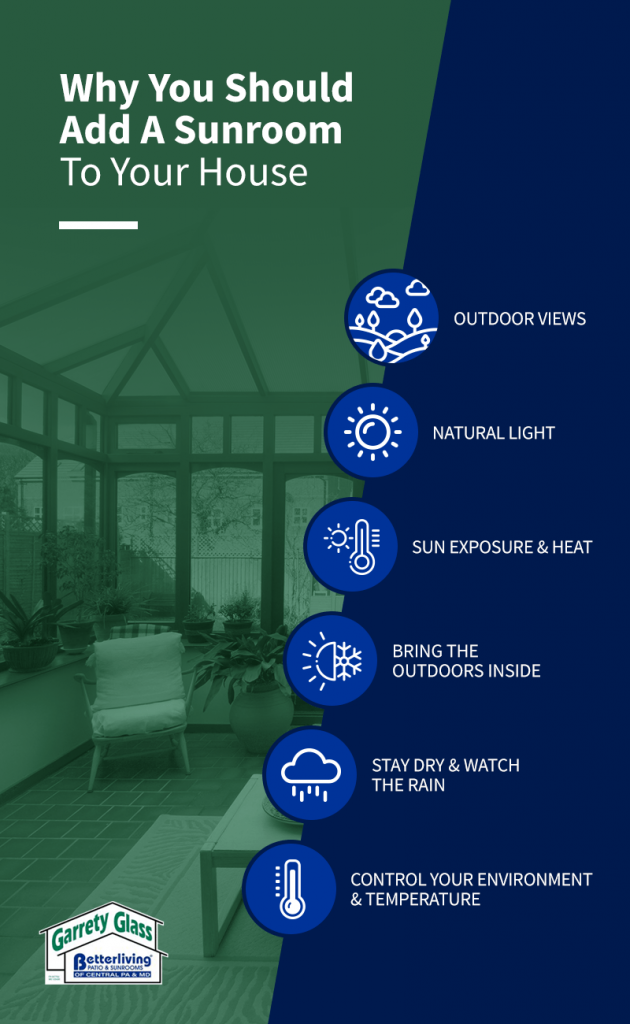
Where to Place a Sunroom
Sunrooms bring outdoor charms into your house while offering a series of perks, from improved aesthetics to additional comfort. Maximize the benefits of a sunroom by choosing the best location. Do you prefer a sunroom that oozes with natural light? Or do you want it to be more secluded and away from your neighbors’ attention?
Decide on the location before diving into the process.
- Front of the house: Install a sunroom in front of your house and enjoy some morning rays.
- Exterior side: An east-facing sunroom exterior works best if you love the morning light.
- Back of the house: For breathtaking sunset views, install the sunroom in the south section.
- In the backyard: You can also create a separate sunroom in the backyard for your plants.
Key Considerations When Choosing the Sunroom’s Location
Besides finding the most suitable location with your preference and comfort in mind, there are other relevant factors you need to consider before installing a sunroom. Here are some key elements to help you decide and make the most out of this beautiful addition:
- Local climate: The weather conditions where you live influence the practicality of adding a sunroom. Know your region’s local climate and seasonal needs to enhance the room’s convenience and comfort.
- Light direction: Determine the direction of light during different seasons. Most sunrooms with southern exposure get more light during the colder months. On the other hand, sunrooms with northern exposure have less light come winter.
- Insulation capability: Proper insulation is also vital when picking the sunroom’s location. Is it possible to insulate the room to cater to both the summer heat and the winter breeze? Consider your level of comfort and insulation costs thoroughly.
Types of Sunrooms
Find a sunroom option that incorporates seamlessly into your home. Choose from a high-quality selection of sunroom styles that allow you to enjoy the scenery of the outdoors without interacting with the weather, insects or other elements.
Sunrooms also evolved into many different designs and applications like three-season and four-season or year-round sunrooms. While not true sunrooms, other variations you might consider include four-track vinyl porch enclosures and conservatories. Here are the main differences between your sunroom options.
Three-Season Sunrooms
Three-season sunrooms are designed and built to be occupied during the spring, summer and fall. They normally use less expensive and lightweight materials that work to let light in and keep out wind and rain. Three-season sunrooms also are designed to provide shade from the direct sun and offer some cooling during hot summer days.
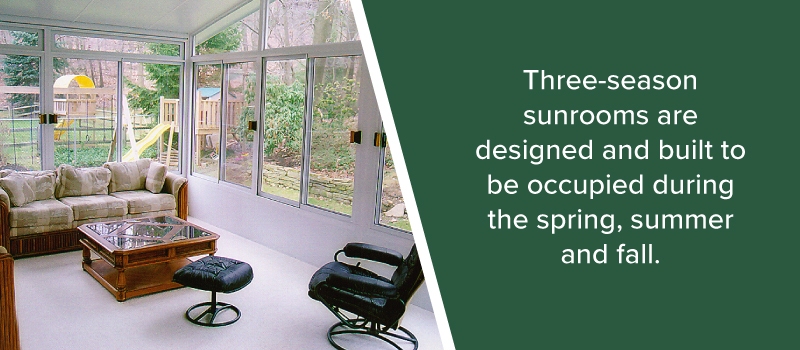
Sunrooms built for three-season use aren’t normally insulated or provided with any auxiliary heat source. They might have fans to circulate air and provide a bit of relief from high temperatures. They may also use temporary space heaters to take the chill offspring mornings or the edge from fall nights.
Three-season sunrooms are economical alternatives to more robust additions made for year-round enjoyment. In warmer climates like Florida where the nickname arose, many three-season room designs can be stretched into four. In cooler locations like south central Pennsylvania and northern Maryland, winter conditions prevent light, uninsulated sunrooms from being used from November through March.
If you live outside the sunbelt and want the soothing effects from your sunroom twelve months a year, then you should consider stepping up to a more expensive and thermally-protected addition like a four-season sunroom.
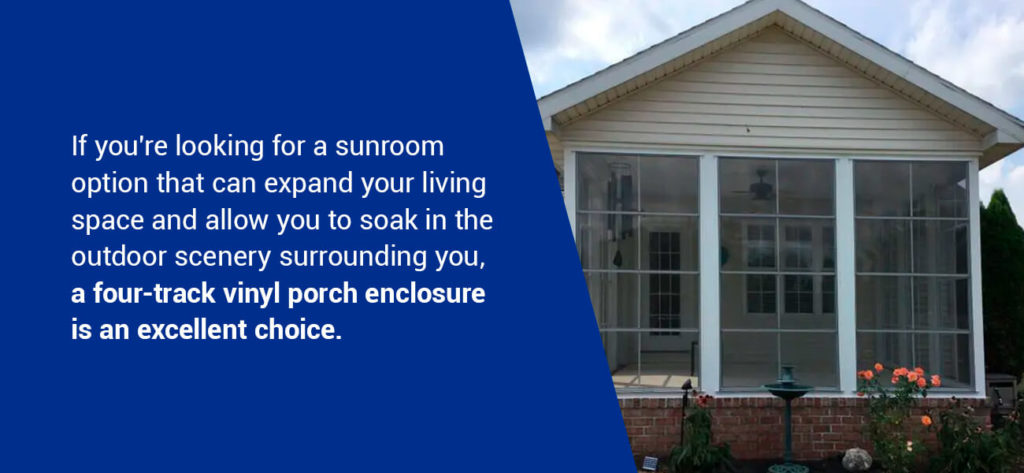
Four-Track Vinyl Porch Enclosure
If you’re looking for a sunroom option that can expand your living space and allow you to soak in the outdoor scenery surrounding you, a four-track vinyl porch enclosure is an excellent choice. The four-track stacking window enclosure is made out of vinyl instead of glass. The material helps protect you and others from UV rays while still allowing natural light to shine into your sunroom. These four-track vinyl windows have some incredible features, including the following:
- The windows are available in custom sizes to fit your existing patio sunroom or outdoor space.
- Professionals can install four-track windows horizontally or vertically to ensure the best look and fit for your sunroom.
- Each window panel comes with a full fiberglass mesh screen allowing you to enjoy the nice weather.
- Installation of a four-track vinyl porch enclosure is much faster than other patio sunroom options.
- The window panels are damage-resistant.
- You’ll feel confident with a five-year warranty on your new four-track porch enclosure.
A four-track vinyl window system is a great sunroom choice for many homes. This type of sunroom has numerous benefits, including:
- Increase your living space: You can host more friends and family inside your home with a four-track porch enclosure. You can utilize this space all year long, so the weather isn’t stopping you from enjoying more of your living space.
- Affordable: If you’re looking for an affordable way to create a sunroom, four-track vinyl porch windows will be one of the best options. You’ll have a sunroom made from high-quality materials at a price that will fit your budget.
- Shatterproof windows: Vinyl window panels are flexible and are resistant to many types of damage.
Four-Season Sunrooms
Just as the name sounds, these sunrooms are enjoyed year-round. Imagine setting up your Christmas tree and opening presents in your sunroom. There are no monthly barriers with four-season sunrooms, and that’s because they’re built to take nature’s full force all year long.
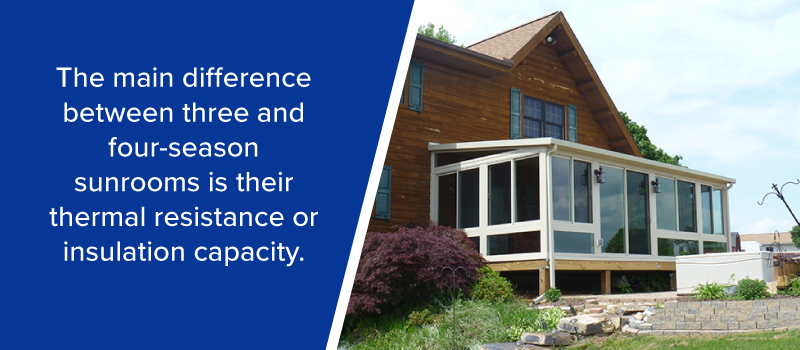
The main difference between three and four-season sunrooms is their thermal resistance or insulation capacity. These are stronger, heavy-duty additions that incorporate double pane glass that may have specialized treatments like inert, argon filling or low-emissivity coatings.
The roofs, walls and doors in four-season sunrooms also contain sufficient insulation and protection against the climate they’re installed in. Many year-round sunrooms appear as an extension of the main house. They incorporate the same roof with overhangs and use the same siding products.
Where four-season sunrooms differ from the main structure is the use of knee or low-height walls. Knee walls usually rise around two feet and allow space for electrical plugs and baseboard heaters. They also use as much continuous wrap-around glass as structurally possible. While most roofs are solid and not glass panels, often multiple skylights are strategic places to capture light.
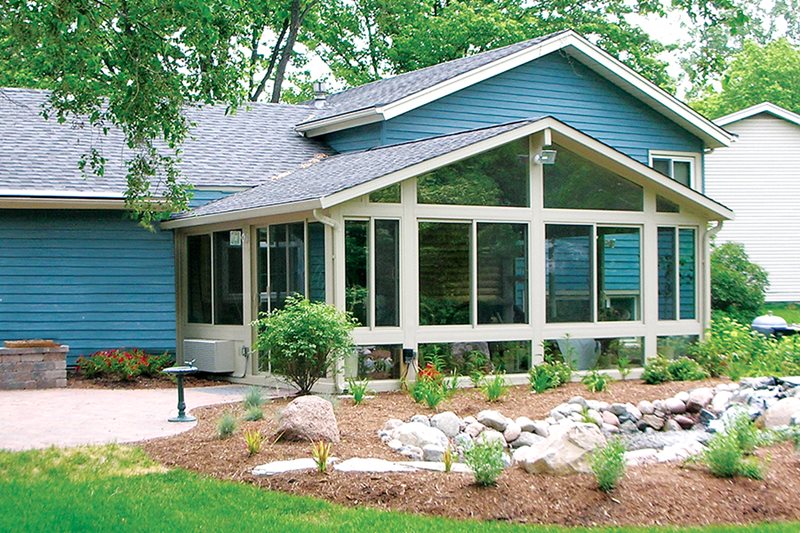
The other main difference in four-season sunrooms is they have artificial heat for cold times. They might also be equipped with air conditioning for hotter days when sitting in a regular sunroom is unbearable. Heat and cooling sources may be hooked into your homes existing mechanical systems or they might be independent. A good sunroom supplier will know what HVAC systems are right for your location and application.
Although three and four-season sunrooms have many uses, it’s important to understand they’re not greenhouses. Sunrooms are designed to control sunlight where direct heat is shaded from the interior, not encouraged to be trapped for solar-gain like greenhouses. Greenhouses are different structures for entirely different purposes. However, house plants and herb planters do well in all sunrooms, as do seasonal flower boxes.
Conservatories
If you’re searching for an elegant sunroom to add to your home, consider a conservatory. Conservatories provide your home with a lovely and bright usable space. They often use more glass or other transparent materials, letting in more light than sunrooms, and feature more dramatic, eye-catching architecture. A skillfully designed conservatory will make a beautiful addition to many types of home styles.
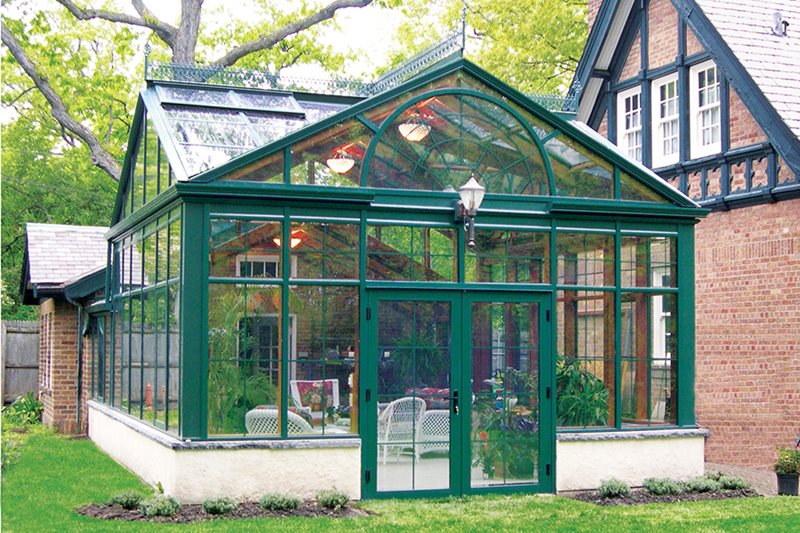
A new conservatory is a sunny space where you can relax or host guests with wonderful views of the outdoors. You can enjoy this type of sunroom all year regardless of the weather. Conservatories also require little maintenance and upkeep other than an occasional clean.
Seasonal use of your sunroom or conservatory is the main consideration when weighing the pros and cons of each type. With so many obvious pros to every sunroom, it’s hard to find many cons. Here are a few small disadvantages to adding a sunroom to your house.
Cons of Sunrooms
The main concern many people have is whether adding a sunroom is worth the cost. There is no right answer to this question because it depends on the homeowner’s needs and budget. The personal enjoyment and lifestyle value you’ll get from a sunroom addition may be priceless. It’s impossible to put a cost figure to the peace and pleasure you’ll get from your sunroom.
Depending on where you live, there may be other cons to consider before adding a sunroom. Some other concerns regarding adding sunrooms may include:
- Possible increase in property taxes
- Potential adjustment to your insurance rate
- Extra utility expenses, especially if you add a four-season sunroom
- Limited privacy that may require drapes, blinds or other window coverings
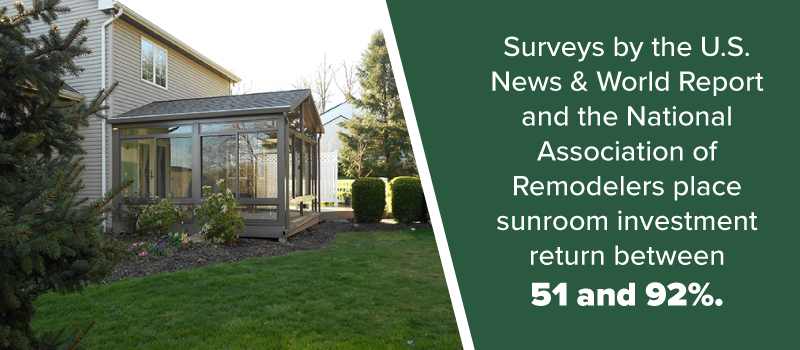
For those concerned about increased property taxes, consider the flip side, which is an increase in home value. Many buyers in the Northeast and Midwest place a higher value on homes with sunrooms than purchasers in the South and West. Surveys by the U.S. News & World Report and the National Association of Remodelers place sunroom investment return between 51 and 92 percent.
Ask your sunroom provider about some of your concerns. They’ll be happy to help you with whatever cons you might see about adding a sunroom to your home. That includes answering your other questions like, “How much do four-season sunrooms cost?” and “How much does a three-season room cost?”. Check to see if there are frequently asked questions about sunrooms as well.
Sunroom Addition Costs
Now that you understand what exactly a sunroom is, and the benefits of having one added to your home, you may be wondering “What is the cost of a sunroom addition?” The average cost of a sunroom addition can be anywhere between $20,000 and $70,000 depending on a number of factors. Some factors that impact the cost of a sunroom include:
- Size of the room
- Quality of the materials to be used (vinyl vs wood for example)
- Whether the room is being built from scratch or on an existing deck or foundation
- Electrical and HVAC requirements of the room
Here’s how costs of sunroom addition compares to other room addition projects:
| Room Addition Project | Average Price Range |
| Sunroom | $20,000-$70,000 |
| Vinyl Porch Enclosure | $6,000-$20,000 |
| Screen Room | $15,000-$50,000 |
Sunroom cost also depends on such variables as:
- The area you reside: Some places like high-demand cities can be more expensive than rural areas with lower labor rates.
- The location of your sunroom: You may have difficult site preparation issues or challenges in tying into your existing structure. Demolition of old construction may also be costly.
- Energy efficiency: Many high-tech, energy-reducing products are available but increase in cost with sophistication.
- Finished surfaces: Elaborate millwork and stone flooring will drive up the price.
- Dependable sunroom contractor: Established companies carrying overheads may quote higher estimates than start-up or fly-by-night businesses. Choosing a contractor based on low price may be a higher cost in the end.
Maintenance and Care
Just like any part of the house, maintenance and care are pivotal in keeping the sunroom clean and appealing all year round. Here are some tips for maintaining a sunroom and ensuring its longevity:
- Regular cleaning: Remove all dirt, stains and debris on the frame, windows, interior surfaces and sunroom exterior. When cleaning the windows, use a mild dishwashing detergent and rinse gently.
- Seasonal preparation: Prepare the sunroom during the colder months by insulating it. Consider adding weather-stripping or insulated drapes to maintain the room temperature.
- Repairs and replacement: Inspect the structure for common signs of wear and tear. Check for leaky window seals, damaged frames, screen holes or damaged flooring.
Choosing a Quality and Dependable Sunroom Contractor
Your choice of sunroom contractor may be your biggest consideration when planning this addition to your home. Quality, dependable contractors need to charge a fair price for their work and they earn it. Not all sunroom contractors are equal by any stretch. Make sure you check out a sunroom supplier as closely as you investigate the design and materials you’d like.
Some things to consider in a sunroom contractor are:
- How long they’ve been in business. Make sure your contractor has been operating for some time and plans to be around for a lot longer.
- Their specialization in sunroom design and installations. Sunroom specialists know the peculiarities of sunroom construction. It takes experience to build a leak and trouble-free structure.
- They’re customer-focused. Many companies talk about customer service but don’t deliver. Great companies have great people who look after their clients’ needs. Take a look behind the company scenes and listen to what previous customers have to say.
- They’re licensed and insured. Find out if they’re a member of a local homebuilder or renovation association. Check their record with the Better Business Bureau.
- They have examples of sunrooms they’ve built for others. Visit their showroom and inspect products for fit and finish. Your eye will tell you a lot.
- They handle all aspects of sunroom additions. This includes obtaining building permits and arranging inspections. A quality sunroom contractor will thoroughly handle your project from start to finish.
- They provide excellent warranties. All reputable sunroom contractors stand behind their work and back it up with a comprehensive warranty. They have strong relationships with their material suppliers and installation crews that minimize the chance or problems. However, when issues arise, they’ll take care of you.
- They avoid using prefabricated sunroom kits. They custom build your sunroom to blend into your home. Good contractors use individual components that specifically work for your job. They don’t work with kits or try making one-size-fit-all.
- They are easy to communicate with and don’t use high-pressure sales pitches. Quality sunroom contractors spend time giving you honest information and then step back. They let you make an informed decision about adding a sunroom to your home.
Partner With the Glass Experts for Your Sunroom
Bask in the sun and take in the beauty of nature from the comfort of your home. Adding a sunroom is worth the cost, especially if you love to get your fill of vitamin D.
Choose us as your glass experts for a high-quality sunroom that will last long. Garrety Glass takes pride in being a quality sunroom supplier to satisfied clients throughout South Central PA and Northern Maryland. Because our customers have such unique needs, we offer an extensive range of products for your sunroom addition.
Our Sunrooms come with a 50-Year Warranty and are backed by the Craft-Bilt Manufacturing Company, which has been an industry leader since 1946. We use a simple business formula: Quality Products + Fair Price + Best Installation & Service = Everybody Wins.
Learn more about what sets us apart from other York and Harrisburg sunroom companies when you visit our showroom. Request a free consultation with Garrety Glass today.